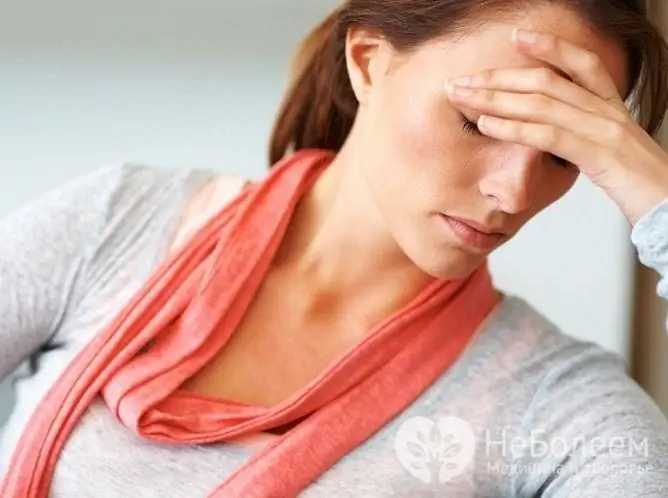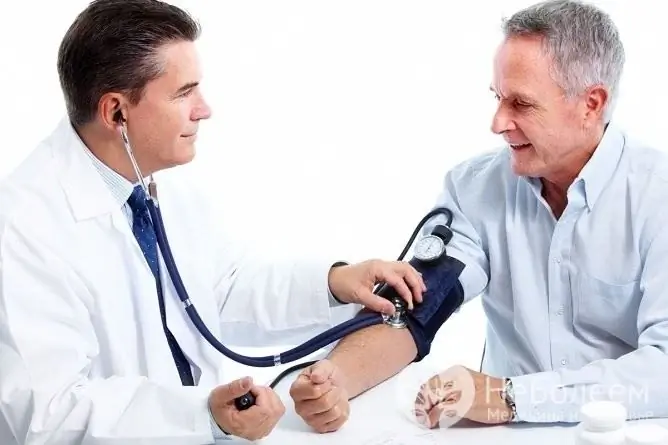- Author Rachel Wainwright [email protected].
- Public 2023-12-15 07:39.
- Last modified 2025-11-02 20:14.
Effective blood pressure lowering: how to quickly lower blood pressure at home
The content of the article:
-
Activities that lower pressure
- Increased stress resistance
- Limiting salt intake
- Normalization of body weight
- Regular physical activity
- Rejection of bad habits
- How to quickly reduce blood pressure at home without medication
- What to do if blood pressure does not decrease without drugs
- What is blood pressure
- Why does blood pressure rise?
- Video
Many patients are concerned about the question "how to effectively and safely lower blood pressure at home without pills?"
In fact, it is possible to achieve a decrease in blood pressure (BP) without taking medication: urgently, with a sudden increase, or in the usual way. For this, various exercises, procedures and herbal remedies are used, as well as changes in lifestyle, dietary stereotypes and daily activity.

It is possible to reduce blood pressure without the use of drugs, but this will not completely solve the problem.
Activities that lower pressure
How to reduce the usual ("working") blood pressure without taking special drugs stable and for a long time? For this, it is necessary, first of all, to eliminate risk factors.
Increased stress resistance
Hypertension is a psychosomatic pathology. This means that one of the main factors in the development of the disease is the state of the psychological background, which is extremely important to stabilize in order to reduce pressure.
The autonomic nervous system, which is very sensitive to changes in emotions, is responsible for the ability of blood vessels to contract and relax. When external pressure arises, which is accompanied by anger, irritation or dissatisfaction, the body responds with a certain resistance. The failure of the regulatory mechanisms does not allow the increasing pressure to be stopped in a short time - a persistent increase in blood pressure develops.
In this case, special exercises can reduce pressure: breathing exercises, muscle relaxation or visualization.
Respiratory gymnastics consists in rhythmic deep breathing (inhalation for 3-4 counts through the nose, followed by exhalation through the mouth of the same duration). In this case, it is recommended to relax the muscles of the shoulder girdle and neck, try to distract from extraneous thoughts.
Muscle relaxation involves alternating the maximum tension of all muscles in the body for 7-10 seconds, followed by their relaxation. At the same time, it is necessary to breathe evenly, rhythmically.
For visualization, it is recommended to take a comfortable position, relax and imagine any pleasant picture (the flow of a river or waterfall, a rainy forest or a sunny meadow). It is also recommended to breathe slowly and deeply.
Limiting salt intake
A prerequisite for the successful treatment of hypertension is to reduce the consumption of table salt. In this case, a complete rejection of the salting of food is not required. The maximum daily amount of NaCl consumed should not exceed a flat teaspoon. It should be borne in mind that vegetables, dairy, meat, fish products and other types of food contain a certain amount of salt. The addition of salting dishes in this case leads to an excess of the NaCl consumption rate at times.
Normalization of body weight
Weight loss is one of the main recommendations for hypertensive patients. The incidence in obese patients is up to 4 times higher than in those of standard weight. The results of numerous studies have proven that with a decrease in weight for every ten kilograms, blood pressure decreases by about 10 mm Hg. Art. For example, in a person with a pressure of 140 to 100 mm Hg. Art. and weighing 90 kg, losing weight up to 80 kg will reduce the pressure to 130/90.
Many patients talk about the refusal of drug treatment or about a significant reduction in the dose of drugs taken after weight loss. For successful, stable and painless weight loss, you must lose no more than 1% of the original body weight per week. That is, with a weight of 100 kg, it is recommended to reduce it by an average of 1 kg / week.
To get rid of extra pounds and thereby lower blood pressure, you need to adhere to a certain diet, not occasionally, but every day. Saturated seasonings that stimulate appetite, spicy and salty foods that provoke thirst, and excessive amounts of animal fats are excluded from the diet, as they contribute to increased deposition of cholesterol in the arterial walls. Preference should be given to plant foods, dietary meats (veal, rabbit, chicken, turkey), dairy products with a low percentage of fat, fish, nuts and cereals.

In the presence of excess weight, its reduction by 10 kg can reduce blood pressure indicators by 10 units
Regular physical activity
It is necessary to eliminate hypodynamia and introduce dosed physical activity into the daily routine. Cardio training stimulates the heart muscle's own blood supply and increases its endurance. When performing exercises, microcirculation becomes more intense, vascular walls are strengthened, inactive capillaries are included in the work. In this case, vascular regulation becomes more adequate.
It must be remembered that excessive loads without prior consultation with a specialist can worsen the condition of hypertensive patients. To draw up an optimal training plan, it is advisable to use the services of a trainer or consultant who will help you choose the optimal activity regimen and suggest appropriate exercises.
If you have hypertension, you need to start classes from 15-20 minutes, weekly increasing their duration by five minutes. As a result, the duration of the workout can be increased to 45-60 minutes (depending on individual feelings).
As activities, you can consider visiting a specialized gym, performing special complexes at home, walking, swimming, cycling, etc.
Rejection of bad habits
It is believed that alcohol lowers blood pressure. This belief is wrong. In small quantities, 15-20 ml in terms of pure alcohol, drinks containing ethanol actually contribute to a decrease in vascular tone. At the same time, the BP figures decrease. However, when this dose is exceeded, the opposite effect develops: the pressure begins to build up, the vascular tone increases.
If a patient suffering from essential hypertension constantly abuses alcohol, it can cause vascular catastrophe, heart attack or stroke. This complication is associated not only with a direct increase in blood pressure, but also with the effect of ethanol metabolism products on the blood coagulation system, the processes of excitation and inhibition, the production of certain hormones and biologically active substances, and the course of redox processes.
Smoking cessation is also an important measure for lowering blood pressure. It has been proven that some components of tobacco smoke, getting into the blood, are able to interact with the aortic baroreceptors. These sensors read the pressure level by sending appropriate signals to the centers of higher regulation. By acting on the receptors, the substances contained in the smoke distort information about the pressure in the vascular bed, damaging the regulatory mechanisms. In addition, hypoxia, which develops during smoking, directly stimulates an increase in blood pressure.
How to quickly reduce blood pressure at home without medication
There are several options for urgently lowering blood pressure without taking medication.
The most popular methods, according to patient reviews:
- A cup of herbal drink. Green tea, oolong tea, broth of hibiscus, mint, caraway have the greatest hypotensive effect. You can drink the pressure-reducing drink both warm and cold. Drinking too hot tea is not recommended. This method is suitable not only for lowering blood pressure at home, but also at work.
- Relaxing massage. It is recommended to take a comfortable position and relax your muscles. The session should last 10-15 minutes, with smooth, light movements it is necessary to knead the neck area, occipital region, shoulder girdle and upper limbs.
- Mustard plasters on the occiput and collar area or on the calf muscles. They are applied until an intense burning sensation appears, after which the procedure is completed.
- Foot bath. Feet must be lowered into a specially prepared container with hot water. The session lasts 10-15 minutes, as the temperature drops, hot water must be added in small portions.
- Compress of table vinegar (up to 15%) on the plantar surface of the foot allows you to relieve pressure in 15-20 minutes.
In most cases, the listed activities allow you to remove blood pressure in a short time. Nevertheless, if within 30-40 minutes the pressure figures do not decrease, and even more so if they continue to increase, you should seek specialized medical help.
What to do if blood pressure does not decrease without drugs
Traditional methods and non-drug methods of lowering blood pressure demonstrate rather high efficiency in far from all patients. It depends on many factors, including the individual characteristics of a particular patient.
If the listed methods did not help to normalize the increased rates, you should consult a cardiologist. Based on an ECG study, daily blood pressure monitoring, ultrasound of the heart and, if necessary, blood vessels, the specialist will determine the nature of the disease.
Depending on the results obtained, the optimal drug therapy scheme will be selected. Lowering blood pressure in this case is recommended by taking the prescribed drugs.
What is blood pressure
Arterial pressure is understood as the force with which the blood from the inside presses against the artery wall.
In the registration of this indicator, it is customary to distinguish two values: the upper and lower numbers, which are correctly called systolic and diastolic pressure, respectively. The readings are recorded in millimeters of mercury (mm Hg), the international designation of the unit of measurement is mm Hg.
Systolic blood pressure (SBP) is determined at the moment when the heart, contracting, pushes blood from its chambers into the arterial bed. Diastolic (DBP) - in the phase of complete relaxation of the atria and ventricles.
Normal values of systolic blood pressure are considered indicators in the range from 100-110 to 139 mm Hg. Art., and diastolic - from 65-70 to 89. If the pressure figures systematically exceed 139 and 89 mm Hg. Art. talk about the development of arterial hypertension.
Why does blood pressure rise?
Hypertension can develop for a variety of reasons.
If the disease occurs on its own, without any connection with any pathology, they speak of primary (essential) hypertension; if, as one of the symptoms against the background of another disease - about secondary, or symptomatic.

People prone to high blood pressure need to keep it under control.
The reason in the first case is the breakdown of internal regulatory mechanisms. In response to the influence of external or internal provocateurs, the body does not respond by adapting the parameters of blood circulation, but by an uncoordinated paradoxical response, which leads to an increase in blood pressure.
In the second case, high pressure numbers are a manifestation of the underlying disease, for example, an adrenal tumor or an overactive thyroid gland.
Essential hypertension is characterized by the presence of risk factors that dramatically increase the likelihood of developing the disease:
- chronic psycho-emotional or physical overstrain;
- excessive body weight;
- the presence of bad habits;
- certain stereotypes in eating behavior;
- lack of physical activity.
It is possible to lower blood pressure in case of symptomatic hypertension by eliminating the underlying disease, which is extremely difficult without the use of medications.
Primary hypertension lends itself to a greater degree of correction without the use of drugs: measures in this case are aimed at stabilizing the regulatory mechanisms.
Video
We offer for viewing a video on the topic of the article.

Olesya Smolnyakova Therapy, clinical pharmacology and pharmacotherapy About the author
Education: higher, 2004 (GOU VPO "Kursk State Medical University"), specialty "General Medicine", qualification "Doctor". 2008-2012 - Postgraduate student of the Department of Clinical Pharmacology, KSMU, Candidate of Medical Sciences (2013, specialty "Pharmacology, Clinical Pharmacology"). 2014-2015 - professional retraining, specialty "Management in education", FSBEI HPE "KSU".
Found a mistake in the text? Select it and press Ctrl + Enter.






